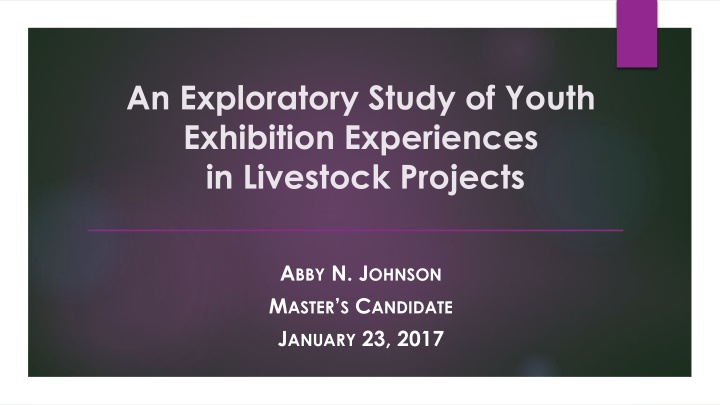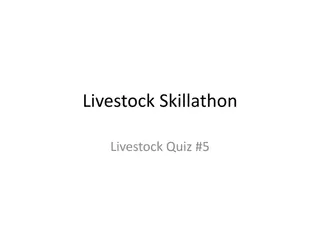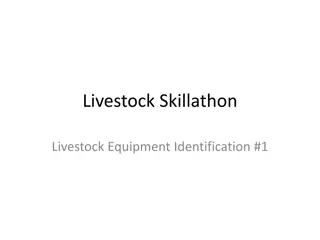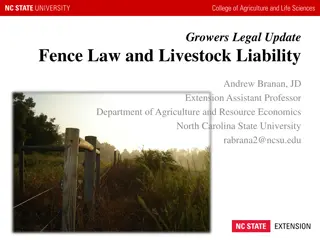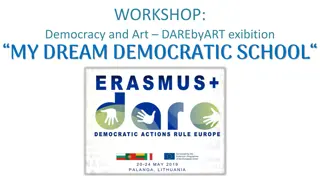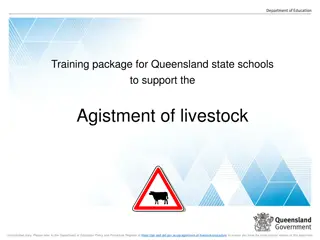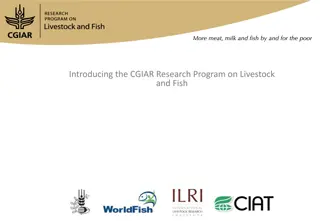Exploring Youth Exhibition Experiences in Livestock Projects
This exploratory study delves into how youth engage in livestock projects, focusing on learning experiences, competition, youth-adult interactions, and life skill development. The study emphasizes the importance of hands-on activities, setting goals, and the role of adult mentors in youth engagement. Livestock projects empower youth with skills like responsibility, time management, and self-motivation, contributing to their overall development.
Download Presentation

Please find below an Image/Link to download the presentation.
The content on the website is provided AS IS for your information and personal use only. It may not be sold, licensed, or shared on other websites without obtaining consent from the author.If you encounter any issues during the download, it is possible that the publisher has removed the file from their server.
You are allowed to download the files provided on this website for personal or commercial use, subject to the condition that they are used lawfully. All files are the property of their respective owners.
The content on the website is provided AS IS for your information and personal use only. It may not be sold, licensed, or shared on other websites without obtaining consent from the author.
E N D
Presentation Transcript
An Exploratory Study of Youth Exhibition Experiences in Livestock Projects ABBY N. JOHNSON MASTER S CANDIDATE JANUARY 23, 2017
2 What is a Livestock Project? Beef, goats, sheep and swine. Largest animal science project that enables youth to develop their interest in a particular species. Youth livestock exhibitors learn: Animal selection Animal care Animal nutrition Animal health Record keeping Youth exhibitors competitively exhibit their livestock project at a county or state fair (Purdue University Extension, 2015).
3 How do Livestock Exhibitors Learn? Hands-on activities (4-H, 2015) Setting goals for themselves and their animal (4-H, 2015) National 4-H Curriculum (4-H, 2015) Project rules (Emo, 2008) Working with adults (Gamon, Laird, & Roe, 1992) Levels of success in the show ring (Davis, 1998)
4 Competition in Livestock Projects Livestock projects are one of the 4-H Organization s biggest competitive endeavors (Keith & Vaughn, 1998). Competitive livestock shows provide youth exhibitors with educational experiences (Davis, 1998). Competitive livestock shows motivate youth to set goals and strive for excellence with their project (Midura & Glover, 1999).
5 Youth-Adult Interaction Youth-Adult interactions are a critical feature to the development, psychology and engagement of youth (Zeldin, Christens, & Powers, 2013). Social interactions allow adults to pass on information, values and goals on to youth, directing youth s thinking in a specific area of interest (Bronfenbrenner, 1979). Project workshops, activities and livestock shows allow youth to engage with their Extension Educator and 4-H volunteer. Youth exhibitors also interact with their parents, feed specialists, show jocks and other agricultural professionals (Jarrett, Sullivan, & Watkins, 2005).
6 Life Skill Development Livestock projects empower youth with skills needed to be successful throughout a lifetime (4-H, 2015). Youth engagement in a livestock project (Boleman, Cummings, & Briers, 2004). Life skills developed through livestock projects: Responsibility Time management Setting goals Record keeping Self-motivation Communication
7 Need for Study Life skills have been identified in previous livestock project literature (Rusk, Summerlot-Early, Machtmes, Talbert, & Balschweid, 2003; Boyd, Herring, & Briers, 1992). Adult mentor involvement can affect youth s engagement and performance in a competitive activity (Davis, 1998). This study examined the extent to which the following factors influenced the youth exhibition experience and perceptions of life skill development in a livestock project. Youth s view of competition Sources of livestock knowledge Youth-adult interactions Youth s motives for exhibiting livestock and their perception of their parent s motives
8 Significance This study will: 1. enhance the effectiveness of volunteers and adult mentors involved in youth livestock projects. 2. lead to the enhancement of professional development practices for extension educators and volunteers. 3. inform adults and volunteers of youth s motivation s for participating in livestock projects. 4. enrich parent s awareness of youth livestock exhibitor experiences and outcomes.
9 Problem Statement Livestock projects are very popular and highly competitive in the state of Indiana (4-H, 2015). Competition through livestock exhibition can be used as an educational tool, but it can have both positive and negative effects on the exhibitor (Homan, 2006). The adult s role and attitude can have a major influence on the youth s exhibition experience. There is little understanding on the role that adult mentors play as it pertains to competition and knowledge outcomes for youth in livestock projects.
11 Theoretical Framework Positive Youth Development (Life Skills) Ecological Systems (Adult Interaction) Self-Regulation (Youth Component)
12 Theoretical Framework Self-Regulation Contends that thoughts, feelings, actions and goals are all self- generated and that youth learn on their own and take their own responsibility or personal initiative (Zimmerman, 1994). Positive Youth Development PYD is a fundamental assumption that results in positive, enduring features in a young person s life that is achieved through guidance, support, opportunities and involvement (Mahoney & Lafferty, 2003; Lerner, 2002). Ecological Systems Theory Implies that a child s development lies within the context of the relationships that form an individual s environment (Bronfenbrenner, 1992).
13 Purpose The purpose of this study was to describe and explain factors that predict youth livestock exhibitors perceptions of life skill development informed by their livestock exhibition experiences, youth-adult interactions regarding livestock knowledge, views of competition, and livestock exhibition motives.
14 Research Questions 1. What were youth exhibitors livestock exhibition experiences (i.e., number of years participating with different species, number of species shown, level of success, type of livestock shown, number of shows, level of shows)? 2. Which adults (i.e., parent/guardian, show jock, 4-H volunteer), according to the youths perceptions, served as sources of livestock knowledge and modeled positive behaviors regarding livestock exhibition? 3. What were youth exhibitors views of competition and perceptions of livestock exhibition motives (i.e., youth perception, youth s perception of parent/guardian)?
15 Research Questions 4. To what extent did youth perceive the development of life skills through their livestock project? 5. To what extent was there an agreement of youth s livestock exhibition motives and how they perceived their parent/guardians motives? 6. To what extent could youth exhibitors livestock exhibition motives (i.e., competition (aka, winning shows) and learning (aka, developing life skills, making money, learning livestock skills) be predicted based on youths livestock exhibition experiences (i.e., youth-adult interactions, view of competition, the extent adults served as sources of livestock knowledge, youth perceptions of parent/guardians livestock exhibition motives)?
16 Population Population High school agriculture programs that included students who participate in a livestock project. Indiana state fair livestock show results, 4-H/FFA livestock related CDE results and the USDA census were used to determine counties used in the study. After determining counties, one agriculture program from that county was chosen to participate in the study. 5 schools/agriculture programs.
17 Participants 159 participants/livestock exhibitors. Average age: 15 years old Average years in 4-H: 6.72 Criteria: Male: 60.4% Female: 39.6% Were a full time student enrolled in at least one agriculture course. Species shown most among participants: swine (47.2%) Species shown least among participants: goat (11.9%) Were a member of 4-H. Participated in either a beef, sheep, swine or goat project. 57.9% of participants raised their own livestock.
18 Instrumentation Youth Livestock Exhibition Experiences Survey Consisted of items regarding: Demographic Information (14 items) Sources of livestock knowledge (13 items) Competition (18 items) Youth-adult interactions (three sections of six items) Life skills (18 items) Livestock project motives (three items)
19 Instrumentation Competition items adapted from competition scales by Harris & Houston (2010) and Radhakrishna, Everhart, and Sinasky (2006). Life skills and youth-adult interaction items adapted from YES 2.0 instrument by Hansen and Larson (2005). Livestock knowledge items adapted from the National 4-H Curriculum (2016) and the Indiana State Standards: Advanced Life Science Animals course (2016). A field test was conducted at a sixth high school agriculture program in Indiana. Completed by 25 livestock exhibitors in the agriculture program. Revisions were made based on feedback from field test participants.
20 Data Collection Emails to high school agriculture teachers and principals sent for permission. Research plan emails sent to teachers after gaining permission. Surveys were administered via class visits by the researcher. Researcher spent one full school day at each of the five participating schools; administering surveys to each agriculture class. Average completion time of survey: 20 minutes
21 Data Analysis Research Question 1. What were youth exhibitors livestock exhibition experiences (i.e., number of years participating with different species, number of species shown, level of success, type of livestock shown, number of shows, level of shows)? Statistical Analysis Means, standard deviations, frequencies and percentages 2. Which adults (i.e., parent/guardian, show jock, 4-H volunteer), according to the youths perceptions, served as sources of livestock knowledge and modeled positive behaviors regarding livestock exhibition? Means, standard deviations and medians
22 Data Analysis Research Question 3. What were youth exhibitors views of competition and perceptions of livestock exhibition motives (i.e., youth perception, youth s perception of parent/guardian)? 4. To what extent did youth perceive the development of life skills through their livestock project? 5. To what extent was there an agreement of youth s livestock exhibition motives and how they perceived their parent/guardians motives? Statistical Analysis Means, standard deviations, frequencies and percentages Means and standard deviations, frequencies and percentages Frequencies and percentages
23 Data Analysis Research Question Statistical Analysis 6. To what extent could youth exhibitors livestock exhibition motives (i.e., competition (aka, winning shows) and learning (aka, developing life skills, making money, learning livestock skills) be predicted based on youths livestock exhibition experiences (i.e., youth-adult interactions, view of competition, the extent adults served as sources of livestock knowledge, youth perceptions of parent/guardians livestock exhibition motives)? Note. Parent s behavior, show jock s behavior and parent s motive (competition or learning) were used as independent variables for the discriminant analysis and youth s motive (competition or learning) was used as the dependent variable Discriminant Analysis
24 Findings
25 Participants reported their parent as their main source of livestock knowledge and skills M SD Knowledge Source Parent 8.21 4.46 Show Jock 2.50 3.58 4-H Volunteer 0.94 2.11
According to youths perceptions, adults modeled highly positive behaviors when working with youth in a livestock project. 26 Median Parent/ Guardian (N=159) 4 4 4 4 5 5 4.08(0.61) Show Jock (N=97) 4-H Volunteer (N=74) My (parent/guardian, show jock, 4-H volunteer) gets upset with me when I don t perform well with my livestock.* is proud of me when I don t do well in the show ring. relationship has improved. and I had good conversations when showing livestock. is controlling and manipulative.* encouraged me to do something morally wrong.* Grand Mean (SD) 5 3 4 4 5 5 5 4 4 4 5 5 4.01(0.59) 4.09(0.60) *Negatively worded items were reverse coded. Note. 1 = Not at All; 2 = A Little; 3 = Sometimes; 4 = Quite a Bit; 5 = Yes Definitely
Participants revealed that competition was a driving force behind their motivation to strive for excellence in their livestock project. 27 Strongly Disagree Disagree Agree Strongly Agree Statement: Competition is beneficial to my positive development. Livestock exhibition places too much emphasis on competition.* Competition provides me with better learning experiences. Competition encourages cheating.* f(%) 0(0%) f(%) 5(3.1%) f(%) f(%) 78(49.1%) 76(47.8%) 18(11.4%) 75(47.2%) 59(37.3%) 6(3.8%) 1(0.6%) 9(5.7%) 56(35.4%) 92(58.2%) 54(34.6%) 47(30.1%) 40(25.6%) 15(9.6%) Competition is an incentive to participate in livestock exhibition. Competition motivates me to strive for excellence. Competition encourages improper parental attitudes.* I am happy for those that win. 8(5.1%) 31(19.9%) 82(52.6%) 35(22.4%) 2(1.3%) 7(4.4%) 46(28.9%) 104(65.4%) 43(27.2%) 70(44.3%) 39(24.7%) 6(3.8%) 6(3.8%) 15(9.4%) 87(54.7%) 51(32.1%)
28 Youth livestock exhibitors gained life skills through their engagement in a livestock project. Quite A Bit f(%) 46(29.1%) Yes A Little f(%) 0(0%) Definitely f(%) 96(60.8%) Through Livestock Exhibition I Not At All f(%) 2(1.3%) Sometimes f(%) 14(8.9%) I set goals for myself. Learned to find new ways to achieve my goals. 1(0.6%) 0(0%) 22(13.9%) 44(27.8%) 91(57.6%) I put all of my energy into this activity. 3(1.9%) 8(5.1%) 41(25.9%) 53(33.5%) 53(33.5%) Learned to push myself. 2(1.3%) 3(1.9%) 18(11.5%) 51(32.7%) 82(52.6%) Practiced self-discipline. 7(4.4%) 7(4.4%) 31(19.6%) 45(28.5%) 68(43.0%) Learned that my emotions effect how I perform. 5(3.2%) 13(8.2%) 26(16.5%) 35(22.2%) 79(50.0%) Livestock exhibition opened up job or career opportunities for me. 21(13.4%) 23(14.6%) 36(22.9%) 21(13.4%) 56(35.7%) Learned about developing plans for solving a problem. 3(1.9%) 13(8.2%) 24(15.2%) 39(24.7%) 79(50.0%)
29 Agreement of Exhibition Motives Agreement vs. Disagreement f (%) Agreement: Competition Disagreement: Youth- Competition/Parent- Learning 4 (26.7%) 11 (73.3%) Agreement vs. Disagreement Agreement: Learning Disagreement: Youth Learning/Parent- Competition f (%) 138 (97.2%) 4 (2.8%)
Pearson Correlations Among the Independent and Dependent Variables 30 Variables 1 2 3 4 5 6 7 8 Parent Behavior1, a ---- SJ Behavior1, b .51 ---- Competition1, a .20 .26 ---- Parent LK1, a .15 -.01 .04 ---- Show Jock LK1, a -.05 .06 .08 -.75 ---- Parent Motive1, c .23 .03 -.10 -.01 -.09 ---- Life Skills2, d .28 .29 .48 -.02 .15 -.11 ---- Youth Motive2, a .22 .30 .01 .08 -.05 .32 .02 ---- Note. SJ = Show Jock, LK = Livestock Knowledge;aN = 159, bN = 97, cN = 157, dN = 158. Item1 = Independent Variables, Item2 = Dependent Variables
Youth livestock exhibitors motives could be predicted and grouped into competition or learning. 31 79.2% of original grouped cases correctly classified Standardized Canonical Discriminant Function Coefficients Predictor Variable Correlation with Discriminant Function Parent Motive .69 .74 Show Jock Behavior .68 .75 Parent Behavior .45 -.05 Predicted Group Membership Competition Learning Actual Group Membership n n % n % Competition 10 6 60 4 40 Nearly four of five youth livestock exhibitors motives could be predicted. Learning 86 16 18.6 70 81.4
32 Implications for Practice Extension educators and 4-H volunteers can use the information gained from this study to improve and develop livestock species programs and volunteer training that includes instructions and strategies on teaching youth livestock exhibitors about their project. Parents, volunteers, show jocks and extension professionals should be aware of the relationships youth livestock exhibitors have with them.
33 Implications for Practice Extension professionals, 4-H volunteers, or other adults could use the Youth Livestock Exhibition Experiences Survey to evaluate the knowledge areas that need to be discussed or to determine where youth exhibitors main motives lie in their local livestock project program.
34 Implications for Theory and Research In order to understand youth s beliefs and development in a specific area of interest, their environment and interactions within that environment must be taken into consideration. For livestock exhibitors who don t have a supportive, helpful environment at home, it is important for 4-H volunteers to become a mentor and source of information for a youth livestock exhibitor.
35 Recommendations for Future Research Collecting data from the parent or adult mentor s perspective on livestock exhibition experiences should be expanded upon in future studies. Examine other areas in the state of Indiana or other states to make the results more generalizable and to determine if the findings are consistent with the findings of this study. Include a qualitative component such as in depth interviews with youth livestock exhibitors or a focus group.
36 Recommendations for Future Research Inclusion of a comparison group or matched paired study between youth exhibitors and their parent, show jock, or 4-H volunteer. Focus on all ages of livestock exhibitors, not just high school aged youth. Examine the FFA livestock project population in order to compare the exhibition experiences of 4-H and FFA livestock project participants.
37 Thank you! Somewhere, someone is practicing. When you meet that person in the ring, face-to-face, one-on-one they will beat you. I m a showman I hate the gate I avoid corners and low spots at all costs I have experienced the Champion Slap and I will do whatever it takes to earn it again and again I think the best spot to watch the Grand Drive is from the ring Don t mess with me when it s show time My favorite color is purple and I show to win Unless that person practicing is YOU. So be THAT showman. Listen to your mentors, put in the extra hours and give it all you ve got. And when you feel like giving up, think is that person giving up? Source: Drive Livestock http://encorevisions.com/project/drive/
38 Questions
